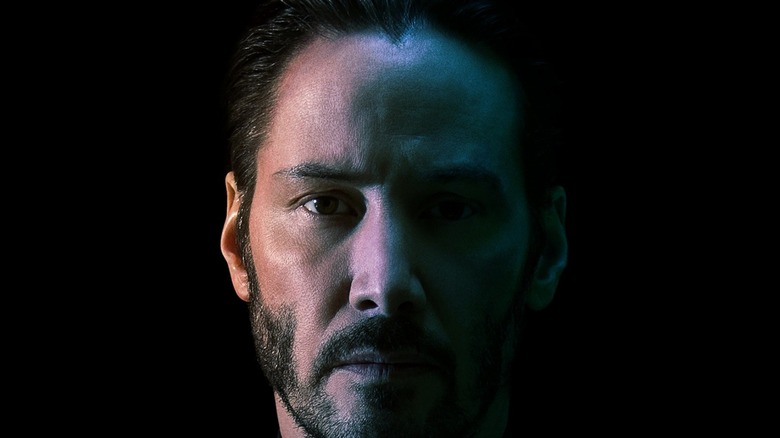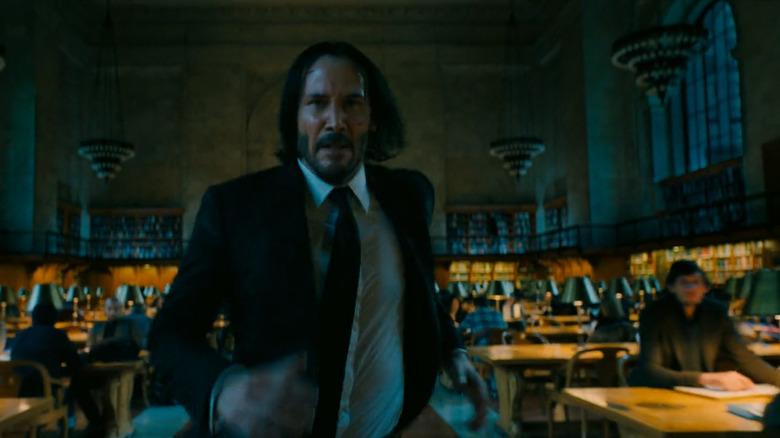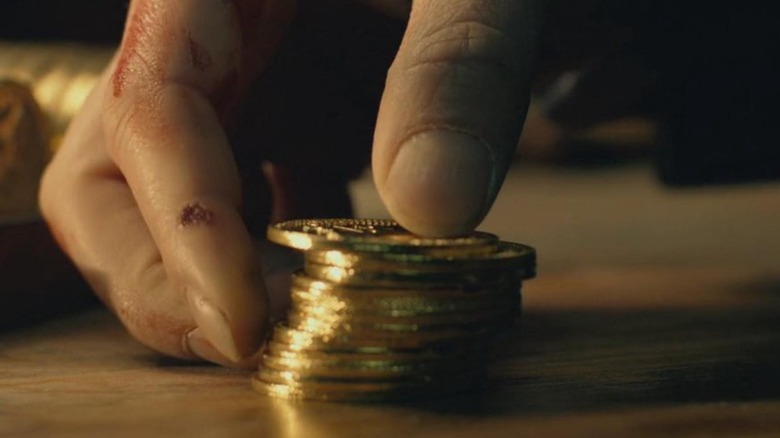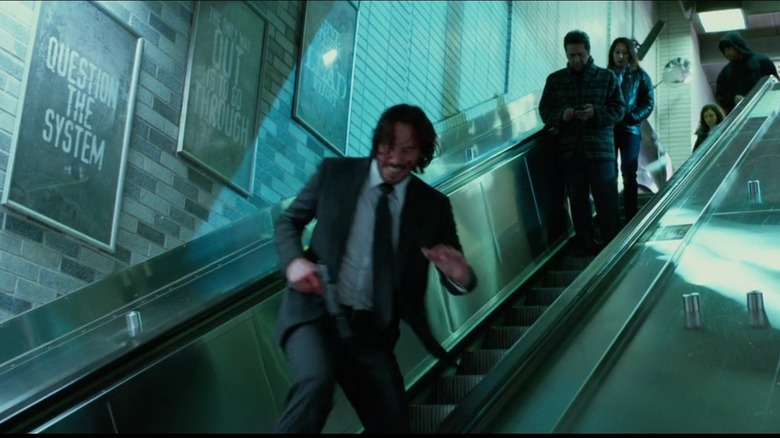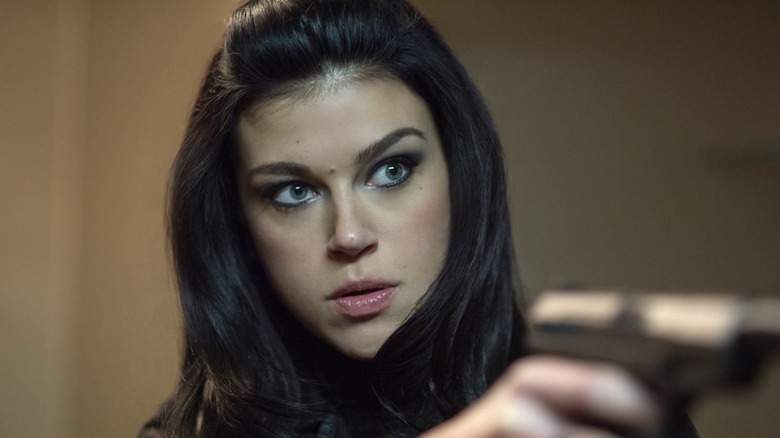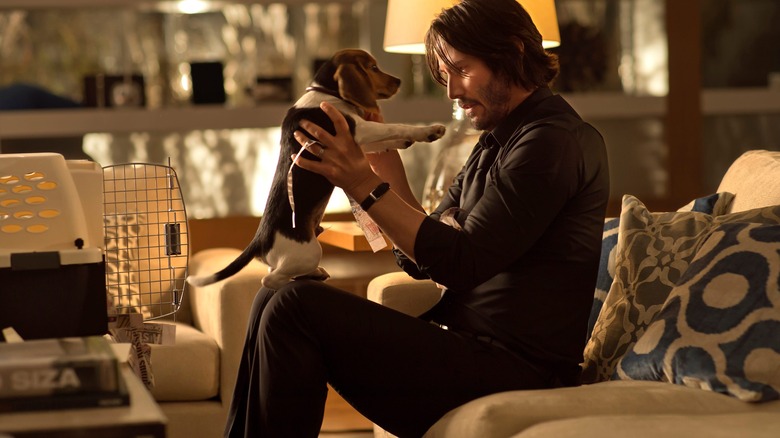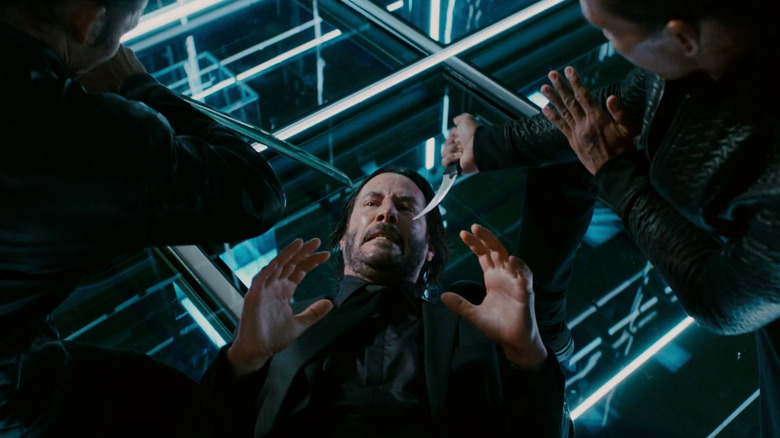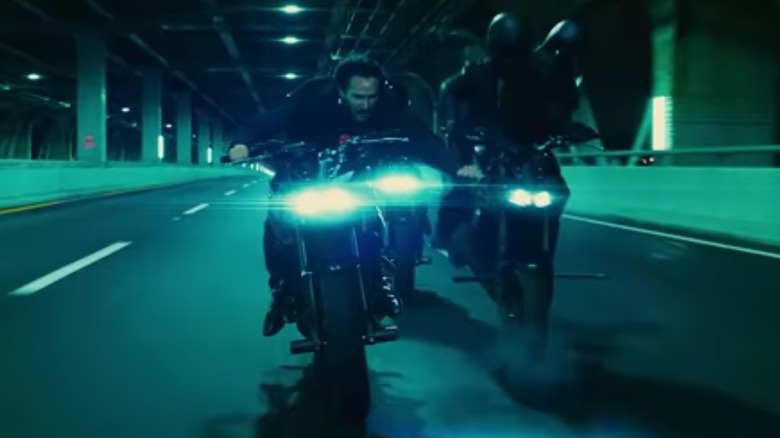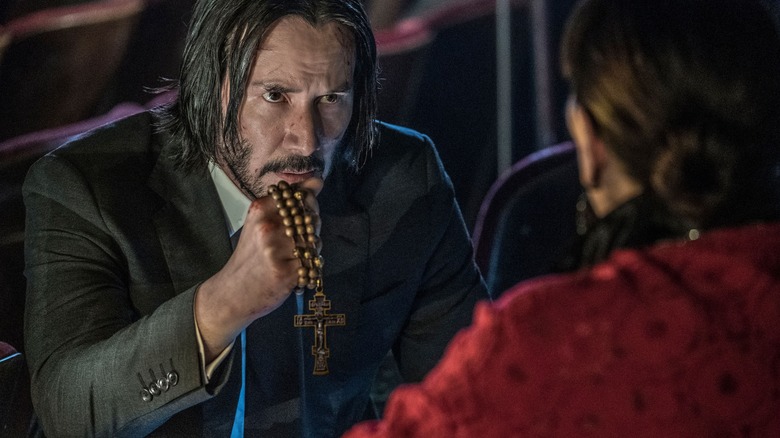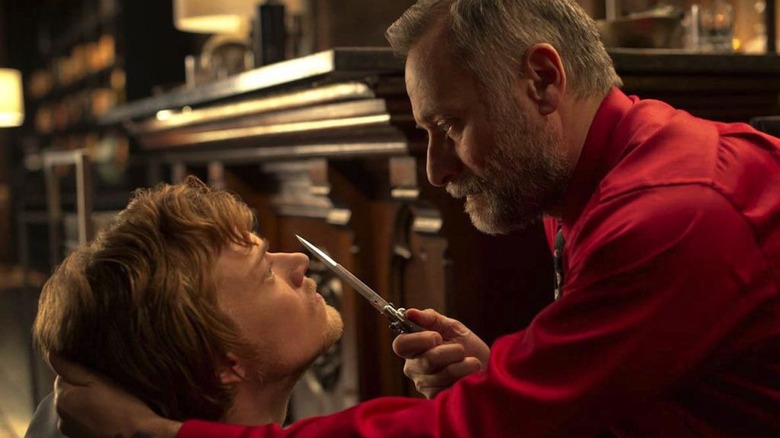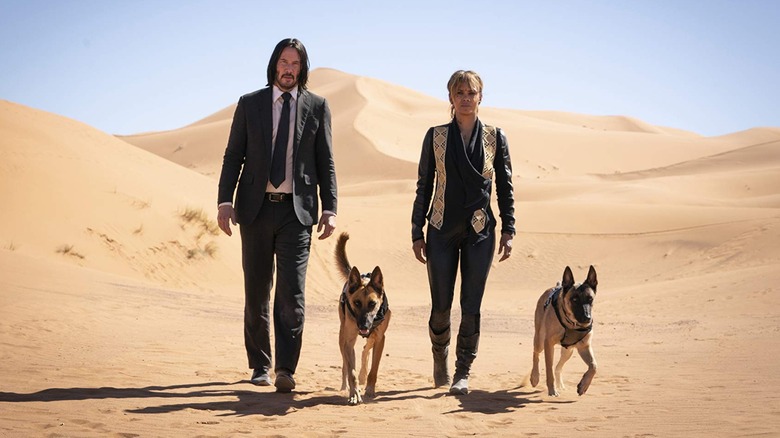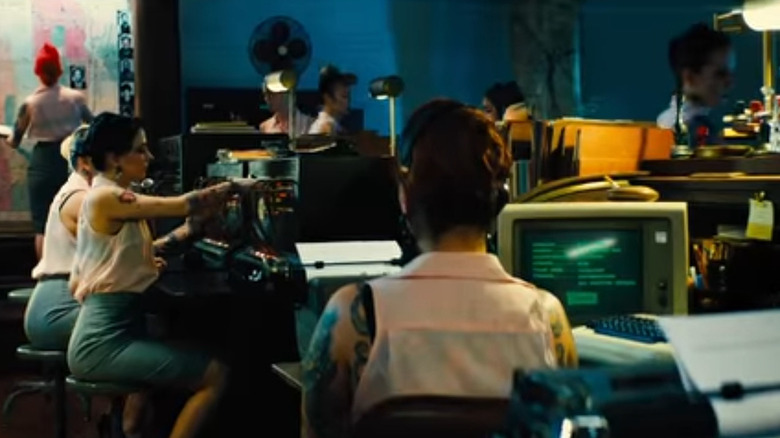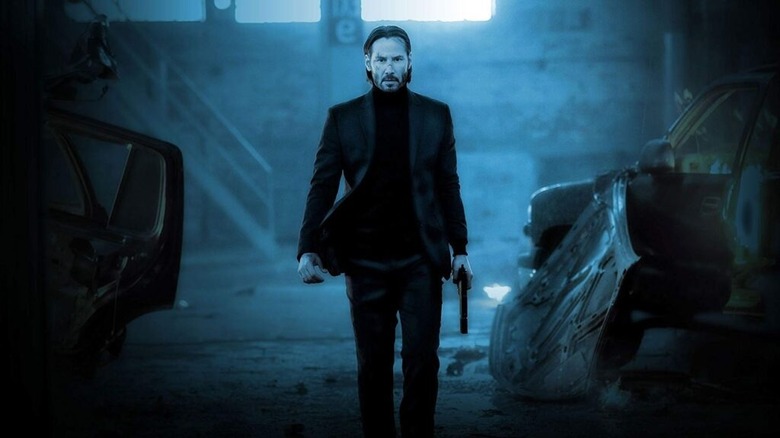Questionable Things We Ignore In The John Wick Franchise
The "John Wick" franchise exists in a reality heightened beyond belief, though when it first started out, it wasn't quite so convoluted. Keanu Reeves stars as the legendary title assassin, a former enforcer for the Russian mob who completed an "impossible task" in order to be released from his obligations so he could spend time with his one true love. After she passes away, he receives a posthumous gift from her: a cute puppy named Daisy whose murder sets off a whirlwind of mayhem that effectively brings Wick out of retirement. Oh, and there's an awesome car he loves, too.
The first film was so popular that it spawned two sequels, with two more installments already planned and a mini-series based on the assassin's place of respite, the Continental, also in the works. Despite the mythologically oversized world, there are still things that seem iffy — little or big touches that aren't quite explained in-world and could leave questions in the audience's mind if the films weren't so outrageously entertaining.
Read on for some questionable things we ignore in the "John Wick" franchise.
Everyone's an assassin?
How are there so many assassins in one place at any given time? New York, in particular, appears to be infested with them.
We discover as the franchise progresses that John Wick isn't the only assassin around. At the Continental Hotel, for example, we learn assassins have their own safe space to relax, unwind and get supplies and assistance.
When John is declared "excommunicado" by Winston, the owner of the Continental, at the end of "John Wick: Chapter 2," everyone who is present where John meets Winston for the declaration turns out to be part of the underworld, and when John begins running, many of the people he runs past receive the excommunicado notification on their cell phones, while others just look at him with recognition. When he gets to Morocco, plenty of the people he walks past also turn out to be assassins.
Why do we ignore this plethora of murderous hit-people hanging out in the same public places? Probably because it's easier not to think about it. It does make sense that they'd all be near the Continental (which turns out to be a worldwide chain, a McDonald's of murder, if you will), and that the various mobs we meet would have enforcers on retainer and kept nearby. But that many in one location at any given time defies real-world logic, and is nonsensical even for the heightened reality of "John Wick." Are they so bad at their jobs that each mob needs to hire several to cover all their bases?
How do assassins pay for necessities?
Everywhere John Wick goes in his shadowy underworld, the Gold Coin is the currency that gets him what he needs, such as medical attention, guns, or a new suit. Everything costs one coin and the people he barters with have no problem accepting them.
As explained by Phil Pirrello at SYFY Wire, the coins aren't just about payment, but about a code that keeps everyone working for the mythical world's High Table on the honor system. You don't see a lot of people breaking the rules because when they do, the consequences are dire. The coins also provide access to services and to the nicer things in the world of assassins and High Table wannabes. What they don't buy, though, is food or other necessities.
We know from the first film that Viggo Tarasov has a lot of cash, and that other mob bosses have cash they launder. Viggo also offers a cash bounty on John Wick to save his son, Iosef, from death at John's hands. If coins are the currency that buys loyalty and silence, why offer cash at all? Why not put bounties that are also paid in coins? Everyone has regular money in this world — the trouble starts for John when he's buying gas, for one thing — but we never see how money is doled out to the people working to earn it.
So many oblivious bystanders
One thing the "John Wick” franchise has plenty of is mayhem. While much of it occurs in places populated mostly by the underworld and their hangers-on, some of it occurs in public spaces where presumably most of the people are innocent bystanders. During some of those public fights, bystanders scream and scatter as soon as the bullets start flying.
In other cases, though, bullets fly and no one seems to notice. Probably the funniest of these fights is the one between John Wick and Cassian — the bodyguard of Gianna, the woman John has been sent to assassinate in "John Wick: Chapter 2." John and Cassian take shots at each other in a subway while everyone else continues to go about their business, seemingly unaware bullets are whizzing by their ears. Sure, both men have silencers on their guns, but silencers don't really work that way and also, bullets hit walls, which makes noise. John and Cassian's fight being ignored when they actually get on the subway is easier to forgive, given the stereotype about New York subway riders.
There's also the Grand Central Station fight in "John Wick: Chapter 3 – Parabellum," where Zero and his henchmen go after John as crowds of passengers walk by. Bodies drop and no one blinks. This can be hand-waved as the fighters all having expert ninja skills and New Yorkers generally keeping to themselves, but it does defy belief that no one is aware.
He's untouchable
Another questionable thing viewers ignore in the "Wick" movies is how assassins from other criminal organizations never come after John while he's vulnerable. Cinematic history has a long tradition of the student coming after the master, from 1972's "The Mechanic" (where a younger hitman takes on his mentor) to countless Westerns like Clint Eastwood's "The Unforgiven," where the "Schofield Kid" has romanticized dreams about following in the footsteps of Eastwood's haunted gunslinger William Munny.
Given the in-world code, it makes sense that no one would touch Wick after he completes Viggo's "impossible task" of assassinating a plethora of people in one night and is released from obligation. But, he's also a mythologically-renowned killer. Which of these swaggering killers wouldn't want his head on their wall?
We also see people willing to set aside whatever scruples kept them within the code in order to score big bucks and put a notch on their belt for taking out The Boogeyman. Specifically, Ms. Perkins in the first film breaks the code of The Continental — no killing business on Continental grounds — without hesitation. She doesn't just try to kill John while he's staying at the Continental, either — she kills Harry, who helped John out. It's an egregious breach of ethics, and she can't possibly be the only one in that world who would be willing to risk the wrath of the High Table to take out the most feared gunslinger of them all.
Everybody loves John Wick
Why is John Wick so beloved that he's virtually untouchable?
It's not just "the code" that seems to keep people away from him when he's out of the life. Everywhere he goes in the first film, he commands respect. Charon (the concierge at The Continental) and Winston seem very fond of him. Harry, another assassin, helps him out. Aurelio clearly has deep respect for him. The Bowery King and others also seem to give him a lot of leeway, despite their past interactions with him.
Is it the dogs? Though it's played for a joke at times, Wick's return to the life is fueled by the theft of Wicks car and the murder of his dog — particularly because the pooch was a gift from his now-deceased wife Helen.
But this is John Wick, The Boogeyman, a man who once killed three people with a pencil. By all accounts, he has murdered as many people as Jason Vorhees. He's pretty damn scary if he's coming after you, and you probably wouldn't be inclined to greet him with a smile. In the real world, if Wick is a known person it is on a John Wayne Gacy-type level of infamy; in the "Wick" movies, he likes dogs, so that makes him a heck of a guy.
Too much honor in fights
Another questionable thing "Wick" fans ignore is how many times — in a fight to the death — Wick's opponent will give him a moment to compose himself before they continue fighting.
The best example of this is the final boss fight with Zero and his henchmen in "John Wick: Chapter 3 – Parabellum." John manages to escape to the Continental after being chased by Zero and his men, and she appears to be safe. However, Winston defies the High Table and The Continental is "deconsecrated," meaning once-forbidden activities are now allowed on the grounds.
Two of Zero's henchmen who are extremely good at martial arts fight with John in the Continental. They are fresh for fighting, while John is tired from all the attacks he's survived. They have a clear advantage over him several times, yet they continuously stop the fight to give John a chance to compose himself — ostensibly as a sign or honor. They have a job to do, but they're so thrilled to fight the legendary John Wick that they wind up losing instead.
In most other films, John would've been dead several times in that fight, or in many of the others he gets into. But in the "John Wick" world, like in a child's game of tag, "time outs" are allowed.
Motorcycles don't work like that
Anyone who knows anything about motorcycles can't help but scoff at moments like when John flips one cycle to take out another. It's a cool-looking stunt, but it's also absurdly unrealistic.
When you look at the behind-the-scenes of stunts such as the motorcycle chase in the third film, you see that CGI bikes can do whatever you want them to. Similarly, John Wick can fall off the roof of a building and survive thanks to the magic of computers (and stuntmen who do the stunts Keanu Reeves doesn't do himself).
Series director Chad Stahelski is a former stuntman himself, so he knows what is physically possible and what isn't. In a world as large and outrageous as that of "John Wick," only the biggest and most outlandish stunts will suffice. So, maybe a motorcycle wouldn't fly backwards, but instead would most likely slide off to the side — but this sure does look cooler.
The outside world doesn't know about Wick's world
Yes, this is a highly-stylized fantasy world, but the increasingly convoluted mythology and public fights makes it harder to believe that the outside world doesn't know any of these turf wars and assassinations are happening. The films make it clear that at least one officer knows who John Wick is, and that's a usual trope for mob movies, but there is no sense of what the non-High Table-types know.
Along with the public deaths where bystanders seem not to notice anything, there are the wild car and motorcycle chases, the explosions, and even that moment when John Wick is on a horse in the middle of the city. The franchise posits that there is a code among the assassins where no bystanders are to be harmed, but someone must get accidentally killed by a stray bullet from time to time — which would then come with cops, investigations, headlines. The police officer who knows John is presumably on the payroll — so, is everyone else in the world as well? Is anyone glimpsed on screen truly innocent? It's hard to tell.
Iosef doesn't know his dad's enforcer
Iosef Tarasov is portrayed as an indolent, spoiled brat. He's entitled, arrogant, and unfortunately for him, not very bright because he goes after John Wick. But seriously, how does he not know who John Wick is?
Once Aurelio realizes the car Iosef has brought to his chop shop belongs to Wick, he rats him out to his father, Viggo, the head of the Tarasov crime family. Viggo has a talk with his insubordinate son, explaining that John Wick is more than just some assassin — he's the most feared enforcer of all, and he was once on Viggo's payroll. Iosef, in all his entitlement, thinks he can just take out John himself. He truly has no idea who he has upset.
The thing is, everyone in the Wick world knows who John Wick is. They know the pencil stories, they know his nicknames, they know he got out. How does Iosef, the son of the man who employed Wick, not have any recognition of the man he took everything from? How did he not recognize him, especially after John spoke the same Russian dialect to him? Iosef's clearly a part of his father's business, even if he's not the best "employee" in the organization. Yes, Iosef is a dope, but it's questionable that he wouldn't know The Boogeyman.
The High Table's magical Wick-finding abilities
The "John Wick" franchise is filled with near-impossible events, such as John getting repeatedly hurt and not bleeding nearly as much he should, or motorcycles flying in ways that defy physics. One of the more questionable ones is in "John Wick: Chapter 3 – Parabellum," and it involves John's long trek through the desert.
After being declared excommunicado and finding Berrada, the Master of Coin — err, Sofia's former boss who is in charge of the Coin-making — John learns that he cannot find the High Table, but that they will come to him if he's worthy. He is told to walk and walk until he can walk no more and if he's worthy, the High Table will scoop him up and he will have his audience with the Elder. So, John walks alone for days without water and collapses. He should be dead. There is nothing around him for miles, yet the High Table finds him easily and brings him to the Elder to talk.
How do they find him? Do they have drones? Exceptionally powerful binoculars? Magic? For that matter, how does the High Table function at all? There are obviously switchboard operators, the Elder, and the Adjudicator, but how do they keep everyone in line? It's one of those questions that may never be answered, but depends on the willing suspension of disbelief.
How do normal hits work?
During the "Wick" series, plenty of people get alerted via cell phone that there's a bounty on John Wick's head, and we see one assassin — John's former mentor Marcus — called directly by Viggo to hunt John down before killing Iosef. But how do normal hit assignments work?
One way is the calling in of a marker, which Santino D'Antonio does when he presents the marker to John and tells him to kill Gianna, Santino's sister who is going to be elevated to the High Table. Santino wants that honor for himself, but he cannot be seen as the one who removed Gianna from contention (which is why he puts out a bounty on John's head after Gianna is dead).
The films don't show, however, how other assassinations are assigned. While there are plenty of names with monetary amounts listed on the Operators' board, it isn't clear what they mean. Are they bounties like the one on John where anyone can claim it? Are specific hits assigned to particular assassins? Such matters seem to be avoided intentionally, favoring style over tangible world-building.
He's called Baba Yaga, but he's nothing like her
In the scene where Viggo tells Iosef exactly who and how dangerous John Wick is, he refers to him as "Baba Yaga," as well as "The Boogeyman." Or, more accurately, the one you call to kill The Boogeyman. The problem is, John Wick is nothing like her.
According to Russiapedia, Baba Yaga is a mythological woman, specifically an old witch who lives in the forest and eats children. Yes, she's Russian, as is John Wick, which might be why Viggo equates him with her. She is a Russian "boogeyman," used to scare children into behaving. But Wick is nothing like her if the fairy tales are to be believed — which, if you're all in on John Wick's world, you do. It's a cool nickname, though, and sounds very scary — which is probably why "Wick" fans are willing to look past it.
